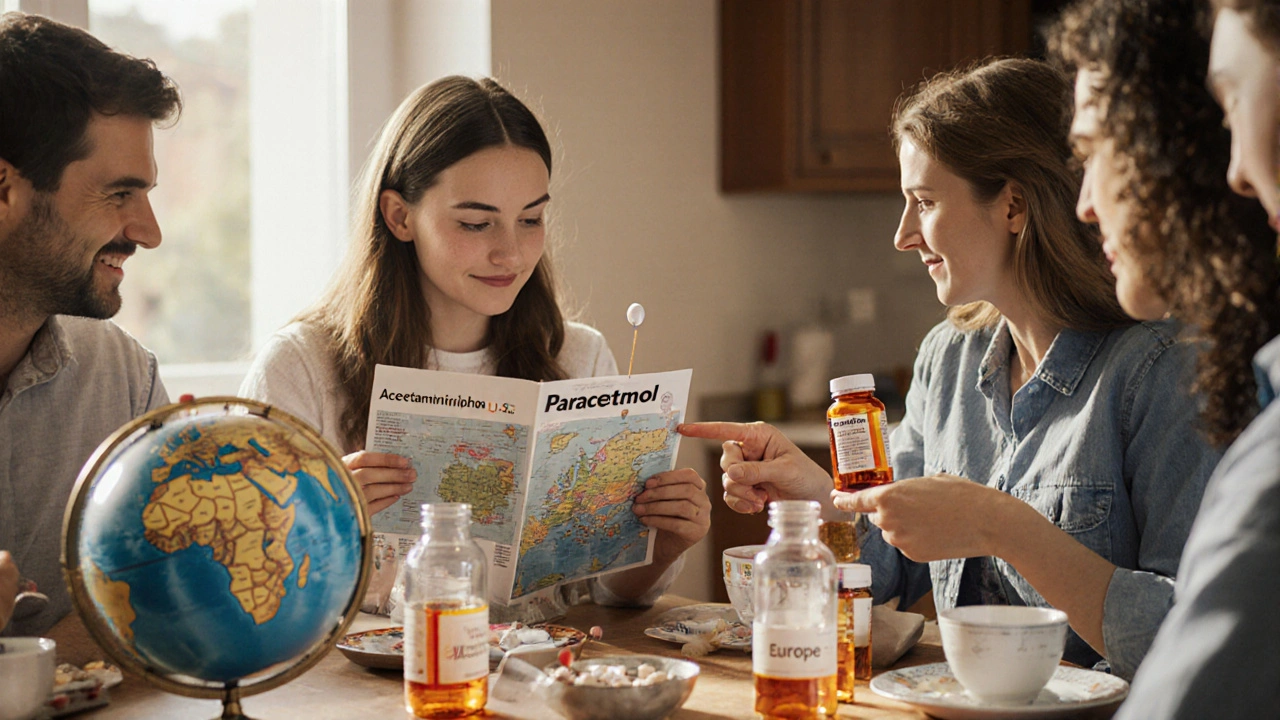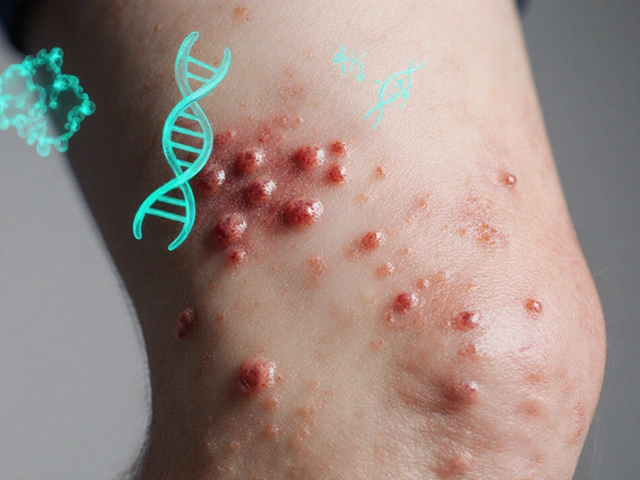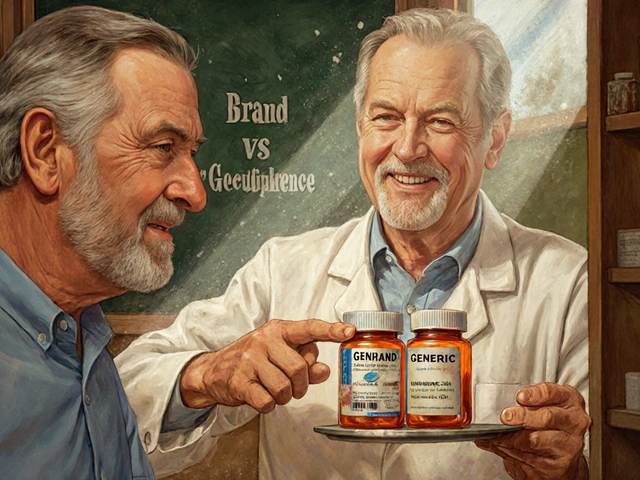Ever wonder why some drugs have two different names? You might see albuterol on your prescription in the U.S., but salbutamol on a bottle from Europe. Or you’ve heard paracetamol overseas, but your local pharmacy sells acetaminophen. These aren’t typos-they’re the result of two global systems that decide what drugs are called before they ever hit the shelf. Understanding how these names are chosen isn’t just for pharmacists. It’s about safety, clarity, and avoiding deadly mix-ups.
Why Generic Names Even Exist
Every drug has three names: a chemical name (too long for anyone to say), a brand name (like Advil or Lipitor), and a generic name. The generic name is the one doctors use to write prescriptions, pharmacists use to fill them, and patients need to recognize to avoid errors. But here’s the catch: the generic name isn’t just made up by the company. It’s assigned by official bodies that follow strict rules.The goal? Make sure no two drugs sound or look too similar. A name like Hydralazine and Hydroxyzine might seem harmless, but mixing them up can lead to serious harm. That’s why systems like USAN and INN exist-to keep names distinct, predictable, and safe.
What Is USAN?
USAN stands for United States Adopted Names. It’s the system used in the U.S. to assign generic names to drugs. Run by the USAN Council, it’s a partnership between the American Medical Association, the U.S. Pharmacopeia, and the American Pharmacists Association. They’ve been doing this since 1964.When a drug company develops a new medicine, they don’t get to pick the name alone. They submit up to six options. The USAN team then checks each one for conflicts-does it sound like another drug? Is it too close to a brand name? Could it be misread on a handwritten prescription? They also make sure the name fits the naming rules.
One big rule: stems. These are the endings that tell you what kind of drug it is. For example, anything ending in -prazole is a proton pump inhibitor (like omeprazole or esomeprazole). Anything ending in -statin is a cholesterol-lowering drug (like atorvastatin). These stems help doctors and pharmacists instantly recognize the drug’s class, even if they’ve never seen it before.
What Is INN?
INN means International Nonproprietary Name. It’s the global standard managed by the World Health Organization since 1950. Unlike USAN, INN is meant to be used everywhere. If a drug has an INN, it should be the same name in Germany, Brazil, Japan, or South Africa.The INN process is similar to USAN: drug companies propose names, WHO reviews them, and then publishes them for public comment. If no one objects in four months, the name becomes official. But here’s the twist: INN doesn’t always match USAN. About 95% of the time they align, but some key differences remain.
Take albuterol (USAN) vs. salbutamol (INN). Both are bronchodilators for asthma. In the U.S., you get albuterol. In most other countries, you get salbutamol. Same drug. Different name. This isn’t a mistake-it’s a legacy of historical adoption. The same goes for acetaminophen (U.S.) and paracetamol (everywhere else). These differences aren’t going away anytime soon, and they’ve caused real-world errors. There are documented cases of patients getting the wrong dose because their prescription was written in a different naming system.

How Stems Work-And Why They Matter
Stems are the backbone of both USAN and INN. They’re not random. They’re carefully designed to tell you something about the drug.- -mab = monoclonal antibody (e.g., adalimumab)
- -ximab = chimeric antibody (part mouse, part human)
- -zumab = humanized antibody (mostly human)
- -prazole = proton pump inhibitor
- -virdine = non-nucleoside reverse transcriptase inhibitor (HIV drugs)
- -feron = interferon-based therapy
These stems let a pharmacist look at a name and know, without checking a reference, whether it’s an antibiotic, an antidepressant, or a cancer drug. That’s life-saving in emergencies.
But stems aren’t just about function. They also handle chemical details. The prefix es- in esomeprazole means it’s the S-isomer of omeprazole-a more precise version of the same drug. The lev- in levocetirizine tells you it’s the active left-handed molecule. These small prefixes carry big meaning.
Brand Names vs. Generic Names
Brand names are marketing tools. They’re catchy, memorable, and often trademarked. Think Prozac, Viagra, or Humira. These names are designed to stick in your mind, not to tell you how the drug works.Generic names, on the other hand, are public property. Once assigned, any company can use them to make a generic version. That’s why after a brand drug’s patent expires, you’ll see the same medicine sold under its generic name at a fraction of the cost.
Here’s the key difference: brand names can be similar. There are dozens of brand names ending in -pril (like lisinopril, enalapril, ramipril)-but those are all generic names. The brand names (Zestril, Vasotec, Altace) are different. The generic name is the anchor. The brand name is the wrapper.
Drug companies spend millions on naming their brand products. They test names for ease of pronunciation, cultural sensitivity, and trademark availability. But they still have to use the official generic name on the label. You’ll see both: Advil (ibuprofen). The brand is on top. The generic is below.
The Naming Process: How Long It Takes
You might think naming a drug is quick. It’s not. It takes 18 to 24 months. The process starts during Phase 1 or 2 clinical trials, when the drug is still experimental. The company submits their name proposals to both USAN and INN. USAN reviews first, then sends the preferred name to WHO for international approval.That’s why you’ll sometimes see a drug named in the U.S. before it’s approved elsewhere. Or why a drug might have a USAN name but no INN yet. The approval process includes checks for conflicts with existing drugs, trademark databases, and even phonetic similarity in other languages. A name that works in English might sound like a swear word in Mandarin. That’s been a problem before.
On average, drug companies go through 15 to 20 name iterations before they land on one that passes both USAN and INN. Most proposed names get rejected. One company submitted 47 names for a single drug before one was approved.

What Happens When Names Don’t Match?
The mismatch between USAN and INN isn’t just confusing-it’s dangerous. In 2018, a study in the Journal of Patient Safety found that international medication errors linked to naming differences cost the U.S. healthcare system over $2.4 billion annually. That’s not just paperwork-it’s hospitalizations, overdoses, and even deaths.Some drugs have been renamed to reduce confusion. For example, the INN for the HIV drug zidovudine was kept as is, even though the U.S. used the same name. But for others, like the anticoagulant warfarin, both systems use the same term. That’s the ideal.
Regulators are trying to fix this. The FDA now requires that all new drugs have names that are as close as possible to their INN. But change moves slowly. Legacy names stick. Patients still need to know both versions.
Future Challenges
New kinds of drugs are making naming harder. What do you call a gene therapy that edits DNA? Or an RNA-based treatment that silences a faulty gene? The old stems-like -mab for antibodies-don’t fit. The WHO and USAN Council are working on new guidelines. In 2021, they updated the monoclonal antibody naming system to cover newer formats like bispecific antibodies. But for RNA drugs, there’s still no standard.Biologics now make up 42% of global drug sales. As these complex therapies grow, so does the need for a naming system that can keep up. The current system has worked for 70 years. But it’s being tested like never before.
What You Should Know
If you’re taking medication, here’s what matters:- Know your drug’s generic name. It’s on the bottle and the prescription.
- If you’re traveling, check if your drug has a different name abroad.
- Don’t assume the brand name is the same everywhere.
- When switching pharmacies or countries, confirm the generic name matches.
Generic names aren’t just technical jargon. They’re your safety net. When you understand how they’re built, you can spot red flags. A drug ending in -prazole should be a stomach acid reducer. If it’s being sold for something else, that’s a warning.
Pharmaceutical naming might seem like a boring, bureaucratic process. But it’s one of the quietest, most effective safety systems in medicine. It doesn’t make headlines. But when it works, it saves lives.
What’s the difference between a generic name and a brand name?
A brand name is created by the drug company for marketing and is trademarked (like Advil). A generic name is the official, nonproprietary name assigned by USAN or INN and is used by all manufacturers once the patent expires (like ibuprofen). The generic name is the same no matter who makes it; the brand name changes.
Why does the same drug have different names in different countries?
Some countries use USAN (U.S.), others use INN (global). While most names match, a few differ due to historical reasons. For example, albuterol (U.S.) and salbutamol (most other countries) are the same drug. These differences exist because USAN sometimes adapts names for U.S. medical practice, while INN prioritizes global consistency.
How do I know if a drug name is safe to use?
Always check the generic name on the label and compare it to trusted sources like the FDA or WHO databases. If a drug sounds too similar to another (e.g., Hydralazine vs. Hydroxyzine), ask your pharmacist. Names are designed to be distinct, but human error still happens. Knowing the stem helps you spot what class of drug it is.
Do generic drugs have the same effect as brand names?
Yes. Generic drugs contain the same active ingredient, dosage, and strength as the brand version. The only differences are in inactive ingredients (like fillers) and packaging. The generic name ensures you’re getting the same medicine, just without the marketing cost.
Can a drug have more than one generic name?
No. Each drug has one official generic name assigned by USAN or INN. However, some drugs have different names in different regions (like acetaminophen and paracetamol). These are not two generic names-they’re two regional versions of the same official name.






Comments
shubham seth
17/Nov/2025So albuterol vs salbutamol is just a US vs rest-of-world thing? Man, I once got prescribed salbutamol in Delhi and panicked thinking it was a new drug. Then my cousin, a pharmacist, laughed and said, 'Bro, it's the same shit.' We need a global naming union. Or at least a drug name translator app. 🤦♂️
Kathryn Ware
17/Nov/2025This is such a vital topic!! 💡 I work in a hospital pharmacy and I’ve seen *so* many near-misses because of naming confusion. One time, a patient brought in a prescription from Mexico with 'paracetamol'-we had to double-check it wasn’t something else because our system only shows 'acetaminophen'. The stems? Absolute lifesavers. -prazole = acid reducer, -mab = biologic, -virdine = HIV… it’s like a secret language that saves lives. I wish every med student had to memorize these like they do anatomy. 🙏
kora ortiz
17/Nov/2025Generic names aren't optional jargon-they're the bedrock of patient safety. If you don't know the difference between hydralazine and hydroxyzine, you're playing Russian roulette with your health. The system works because it's consistent. Stop treating it like bureaucracy and start treating it like a shield. Period.
Kyle Swatt
17/Nov/2025It’s wild how something so technical ends up being the quietest guardian of life. We don’t notice it until someone dies because a name was misread. I used to think drug naming was just corporate nonsense-until my dad had a stroke because a nurse confused two similar-sounding anticoagulants. Now I look at every pill bottle like it’s a poem written by scientists who refuse to let us die from a typo. The stems? That’s poetry with a purpose.
Deb McLachlin
17/Nov/2025It is worth noting that the harmonization between USAN and INN remains an ongoing challenge within the global pharmaceutical regulatory framework. While the majority of nomenclature is aligned, the persistence of regional variants such as acetaminophen/paracetamol and albuterol/salbutamol introduces unnecessary complexity into international pharmacovigilance systems. Further standardization efforts are warranted to mitigate adverse drug event risks.
saurabh lamba
17/Nov/2025Why do we even bother with all this? 😴 It’s just a name. If the pill works, who cares if it’s called albuterol or salbutamol? Probably just corporate BS to make pharmacists feel important. Also, I saw a guy on TikTok say the WHO is secretly controlled by Big Pharma. 🤔
Kiran Mandavkar
17/Nov/2025Let’s be real-USAN is just American exceptionalism in pill form. We can’t even agree with the rest of the world on how to name a drug? Salbutamol is the logical, globally accepted term. Albuterol? That’s a linguistic glitch. And don’t get me started on 'acetaminophen'-it sounds like a chemical weapon. The U.S. needs to stop pretending it’s the center of the pharmaceutical universe.
Eric Healy
17/Nov/2025Stems are cool and all but I’ve seen 'clindamycin' and 'clonazepam' get mixed up and people die. Who’s really checking these names? Probably some guy in a basement with a thesaurus. And why do we have two systems? USA thinks it’s special. I’ve seen typos in FDA docs. If they can’t spell 'pharmaceutical' right, how are they naming drugs?
Shannon Hale
17/Nov/2025THIS IS A NIGHTMARE. I’ve been working in ER for 14 years and I’ve seen THREE patients almost die because someone wrote 'zidovudine' but meant 'zalcitabine'. And now we have biologics? RNA therapies? What are we gonna call those? '-ribonucleothingy'? The system is BROKEN. They’re making up names like they’re naming a new Netflix show. 'Eliquis'?! Who thought that was a good idea? This isn’t medicine-it’s branding gone rogue.
Gordon Mcdonough
17/Nov/2025Why do we trust these 'experts'? WHO? USAN? They’re all in bed with Big Pharma. Did you know the same people who name drugs also get paid by the companies? And the stems? That’s just a distraction. The real reason they don’t unify names is because they want you confused. Confused people buy more drugs. They want you scared. They want you to think you need three different pills for the same thing. Wake up.
Prem Hungry
17/Nov/2025Bro, this is actually super helpful. I’m a med student from India and I was always confused why my US friends said 'acetaminophen' and we said 'paracetamol'. Now I get it. The stems are genius-like a secret code. I’m gonna memorize them all. Thanks for the deep dive. You just saved my future patients. 🙏
Leslie Douglas-Churchwell
17/Nov/2025Of course they don’t unify the names. It’s not about safety-it’s about control. The WHO and USAN are just fronts for the Illuminati’s pharmaceutical agenda. They want you dependent on branded drugs because the generic names are deliberately inconsistent to keep you buying. And those stems? They’re coded signals. -mab? That’s not 'monoclonal antibody'-it’s 'Marked for Biocontrol'. The fact that you think this is 'safety' proves you’re part of the system. Wake up. 🌐👁️
Jeremy Hernandez
17/Nov/2025They spent 18 months naming one drug? 47 names? Bro. That’s a whole season of reality TV. I bet the real reason they don’t fix the USAN/INN mess is because someone’s making bank off the confusion. Pharmacies charge more for brand names. Doctors get kickbacks. And patients? They just get confused. And then they die. And nobody cares. 😒